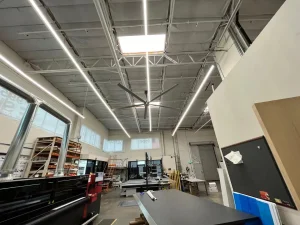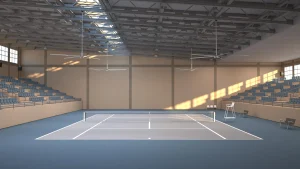Busy facilities often struggle with air circulation. Some areas overheat, while others feel drafty or stale. These airflow inconsistencies can hamper comfort and productivity. A mismatch between high-speed fans and low-speed fans can worsen the problem. The fix? Identify the difference between a high-speed fan and a low-speed fan so you can pick the right fan for your space.
A high-speed fan spins at higher rpm, pushing air quickly over smaller areas. By contrast, a low-speed fan—like a HVLS fan—operates at a slower speed but move air in massive amounts of air across large footprints. High-speed fans are ideal for spot cooling in tighter rooms, while low-speed HVLS fans excel in wide warehouse spaces, improving occupant comfort with minimal energy use. Thus, the difference between a high-speed and low-speed fan hinges on RPM, coverage area, and ideal usage environment.

HVLS Fans in an Industrial Setting
When it comes to climate comfort in warehouse, factories, gyms, or commercial buildings, picking the right fan can transform occupant well-being. So, is a high-speed fan or low-speed fan better for your environment? The answer hinges on your facility’s size and needs, occupant density, and even the local climate.
Each approach has pros and cons. High-speed fans can quickly produce a strong breeze, great for localized spots. Meanwhile, low-speed fans can distribute air gently across large zones, making them ideal for broad coverage and comfort.
The golden rule: bigger, more open areas demand a low-speed fan approach for stable temperatures and consistent occupant well-being.
When you hear about the biggest fans, you might picture enormous overhead fans spinning gently in a cavernous building. These are typically hvls fans, short for High Volume Low Speed. They can measure anywhere from 8 to 24 feet in diameter—some even bigger, depending on fan brand and model.
High-volume or high volume means these fans are designed to push large amounts of air at a slower speed. Because they revolve at low speed—maybe 40 RPM or 200 RPM—they remain quiet yet move enough air to significantly cool or ventilate huge buildings. This is unlike smaller fans which might spin at higher rates but only cover limited square footage.
| Fan Type | Diameter | RPM Range | Usage |
|---|---|---|---|
| HVLS Fan | 8–24 ft | ~40–200 | Wide coverage, large spaces |
| High-Speed Fan | ~1–3 ft | 200–380+ | Focused spot cooling, smaller rooms |
A smaller or standard ceiling fan might operate at higher rpm—like 380 RPM—to produce a breeze in a bedroom. Meanwhile, an HVLS unit could run at 40 RPM yet effectively move air across thousands of square feet in a warehouse. This approach is not only energy efficient but also beneficial for occupant comfort, as the airflow is widespread and gentle.
Stat: According to some data, a single HVLS can replace 10 or more smaller fans in a large facility, lowering overall energy usage and simplifying maintenance.
In short, the difference between a high-speed and low-speed fan lies primarily in three areas: rotational speed, coverage, and typical application. Let’s break down these distinctions further.
High-speed fans might spin in the hundreds of revolutions per minute, providing strong, localized breezes. Conversely, low-speed fans revolve slowly, focusing on large-space coverage. For instance, a hvls fan might top out around 200 rpm, while a standard “high speed” fan might exceed 380 rpm.
Tip: Determining whether a high-speed fan and a low-speed fan approach is best depends on occupant needs, building design, and cost considerations.
When a low-speed fan—like an HVLS unit—rotates, it often has longer blades. Because the fan spins slower, each blade pass moves a continuous, wide column of air. This method fosters consistent coverage from corner to corner. If you want to keep everyone in a warehouse comfortable, a single low-speed overhead fan can handle the job at minimal cost.
A HVLS fan integrates this principle by combining large diameters with moderate speeds. The resulting airflow extends downward and outward. Instead of creating intense gusts in one zone, HVLS solutions circulate the environment’s air gently and thoroughly. Such uniform air circulation helps regulate temperature differences and address humidity pockets—vital for occupant health and product longevity.
Case Study: A beverage distribution center installed low-speed, large-diameter HVLS fans in its loading docks. They saw fewer hot spots near the warehouse entrance, improved forklift driver comfort, and a notable drop in product spoilage from temperature variances.
While large, low speed solutions get top billing for warehouse comfort, high-speed fans can still play a role in industrial contexts. For example, if certain stations in a plant experience high heat—from welding or forging equipment—an elevated fan speed might deliver quick relief. The robust airflow from a high-speed fan can whisk away smoke or fumes rapidly.
That said, relying solely on high-speed designs for an entire building can be suboptimal. You may need multiple units to achieve the same coverage, leading to a patchwork effect where some zones feel over-blown, while others get minimal breeze. Noise can also become an issue, especially if these fans run continuously at top speed. Hence, it’s worth balancing high-speed solutions with an overarching low speed strategy if your warehouse is truly large.
Quote: “High-speed fans can create intense spot cooling, but for large footprints, we suggest HVLS or other low-speed designs to unify the air distribution,” says an industrial ventilation consultant.
High-Speed Fan VS HVLS Fan
When we say “ceiling fan,” many conjure images of a typical home fixture with three or four blades, used in living rooms or bedrooms. But industrial ceiling fans come in a variety of designs. Among them, HVLS stands out as a specialized form for big buildings. So how to know which route to take?
Often, the best option for a warehouse or big indoor sports center is a hvls fan. Because these fans utilize broad diameters, they move air gently yet effectively, ensuring occupant comfort without the intense gusts or noise of higher-speed models. Moreover, HVLS solutions tend to be more energy efficient per square foot of coverage.
Pro Tip: If you want broad coverage, a standard ceiling fan designed for residential use is rarely enough. HVLS is your friend in large, open spaces.
Some “industrial fans” (often box-shaped or caged) spin quickly, delivering powerful but localized airflow. They can be placed on the floor or hung from beams. While beneficial for immediate localized cooling, covering an entire warehouse often requires multiple units—raising complexity, energy usage, and maintenance.
For a warehouse environment, an hvls fan is typically the game changer. Because it’s a low-speed device with broad airflow coverage, you can maintain stable temperature zones with fewer fans, reducing overhead costs in both procurement and electricity. Employees scattered throughout the warehouse will all feel a consistent, comfortable breeze. This uniform environment helps with worker productivity and product safety—especially if you’re storing temperature-sensitive goods.
Data: Studies show that in a warehouse environment, a single HVLS can replace 8–12 smaller high-speed fans, diminishing monthly utility bills and reducing trip hazards or crowding associated with multiple fan installations.
Air conditioner fan speed can be integral to controlling climate. Some building managers rely on a synergy between the AC’s internal fan and overhead fans. By setting the AC’s blower at moderate speeds while using a low-speed fan overhead, you maximize air circulation without blasting cold air in localized pockets.
A building occupant typically wants uniform cooling. If you only rely on a higher speed from your AC fan, you might create strong blasts that quickly saturate the immediate area near vents, leaving far corners less cooled. Conversely, a low speed overhead fan can distribute that cooled air effectively. The occupant experiences consistent comfort, and the AC might cycle less frequently, saving energy.
Conclusion: The synergy of balanced fan speeds plus AC usage helps maintain occupant comfort and keep energy demands in check.
Sometimes, facility managers hesitate between high-speed or low-speed fan solutions. Here’s a simplified breakdown:
| Space Type | Fan Suggestion | Reason |
|---|---|---|
| Small Office (200 or 250 square feet) | High-speed or small ceiling fan | Quick local breeze, occupant can adjust easily |
| Mid-Sized Retail Store | Possibly moderate-speed or multiple smaller fans | Spot cooling for customers, simpler layout |
| Gym/Sports Arena | HVLS or large low-speed overhead fan | Broad coverage, minimal draftiness |
| Large Warehouse | HVLS or big industrial ceiling fans | Single/few fans to unify environment |
| Workshop w/ Hot Machinery | A mix—High-speed near machines, HVLS overhead | Spot cooling + general coverage synergy |
Determining whether a low-speed fan is the better option typically hinges on scale. The bigger your square footage, the more an HVLS approach stands out.
High-speed fans are straightforward for smaller areas, but low-speed fans can unify air conditions across extensive footprints. For many workplaces, that means improved comfort, improved productivity, and fewer overhead hassles.

HVLS Fan in Gymnasium Setting
How fast do high-speed ceiling fans spin?
High-speed ceiling fans spin anywhere from 200 rpm to 380 rpm, producing a concentrated breeze. This is suitable for smaller rooms or personal cooling.
Why are low-speed fans a great option in large warehouses?
Low-speed fans are a great solution for big footprints because they push massive amounts of air gently, improving air circulation coverage. This approach fosters uniform temperatures and occupant comfort with minimal turbulence.
How do smaller high-speed fans compare with HVLS fans?
Smaller high-speed fans revolve at higher rpm, but each covers a limited radius. An HVLS fan rotates at a slower speed, managing a broader area. As a result, you might need many smaller fans to replicate what a single HVLS can achieve.
Are HVLS fans used close to an occupant’s desk or workstation?
Typically, HVLS fans target entire rooms or zones. For personal, up-close cooling, a table or personal fan might be best. HVLS solutions are overhead, meant to unify the ambient environment rather than direct immediate airflow at an individual.
Which is more energy efficient—a high-speed or low-speed fan?
In a large building, a low-speed or HVLS approach is typically more energy efficient. It covers broad areas at minimal watt consumption. In small rooms, a high-speed solution might be simpler and cost-friendly.
High-speed or low-speed—the choice influences occupant comfort, energy efficiency, and your facility’s overall environment. High-speed fans revolve quickly, delivering immediate breezes in confined zones. Low-speed fans, especially HVLS designs, revolve gradually but move air in wide sweeps, perfect for warehouse floors, gymnasiums, or any large footprint.
At our hvls fans Manufacturing enterprise, we know these differences matter. Our mission is to craft and deliver solutions that handle your airflow needs in a streamlined, cost-effective way. If your building is huge, overhead, low speed fans might be the perfect answer. If your place is small, a high speed approach can work wonders. Ultimately, the fan is suitable if it meets your coverage area, occupant needs, and budget concerns.
Remember: The difference between a high-speed fan and a low-speed fan primarily revolves around coverage, rpm, and usage context. By understanding these distinctions, you’ll confidently choose the right fan for your space, ensuring fewer hot spots, improved occupant morale, and lower overhead expenses in the long run.
In the end, finding the difference between a high-speed fan and a low-speed solution is just the first step. Implementing the correct system can transform how your building handles air movement—giving everyone a comfortable climate with reduced demands on the air conditioner fan or heating system. Get in touch with our hvls fans Manufacturing team to learn how we can tailor an HVLS fan solution for your site, letting you reap the benefits of consistent comfort, better occupant morale, and lower utility bills.

Hi, I’m Michael Danielsson, CEO of Vindus Fans, with over 15 years of experience in the engineering and design industry. I’m here to share what I’ve learned. If you have any questions, feel free to contact me at any time. Let’s grow together!